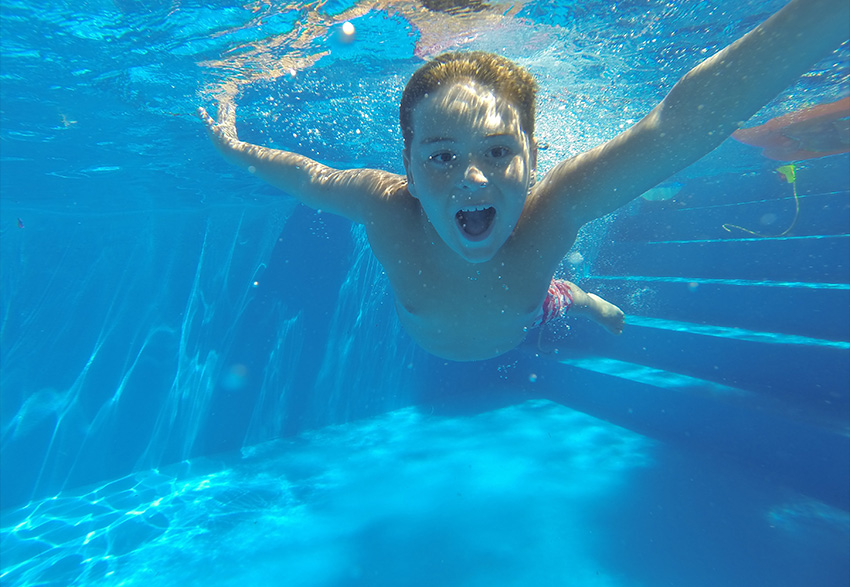Are You Afraid of The Water…Do Not Be! by Katherine Schweit, JD
When I was a child, my mother would always raise her voice as soon as any of us approached water. “Be careful, be careful, be careful,” she would yell. It made me nervous to be near water, even if one of my older siblings would carry me in. I am still a bit scared to this day.
What stymied me even more, is that they had installed a four-foot deep stand up pool for the big-kids summer-time fun in the backyard of our suburban home near Detroit. My parents had given in to the sibling begging and their desire to keep up with the Jones, despite the fact, my mom confessed, that my mom never learned to swim. She was born in Detroit and was very much a city kid. Though wading in the cool water of Lake Michigan was her favorite thing in life to do, she admitted to me as we grew older, that she was deathly afraid of not being able to save one of her eight children if they were drowning.
I think of all the times as kids that we went to Clarks Lake where her friends had a house, and she must have watched from the beach, terrified that one of us might slip into the murky abyss of Michigan’s lake water.
She explained her fear to me when I had my own two girls. “That’s why I made you take swimming lessons at the YMCA.” The water was always cold, and I hated those swimming lessons. My kids spent time in the water, learning to swim, or at least get by. They grew up in a home near a big neighborhood pool, but rarely took advantage of it. Like my mom, they like to be at the beach to hear the sound of the waves but not necessarily swim in the water. It was a blessing for me since I inherited my mother’s concern about drowning.
I still have a healthy respect for water, but those swimming lessons gave me confidence years later when I had to pass a swimming and diving test to earn my FBI badge. In the big indoor pool at Quantico, Virginia, everyone must prove they can jump off the side of a simulated tall ship and into the water, making it back above water safely and employ other survival skills.
But, now I realize I could have broken the cycle if I had taken a few steps as a young parent, steps any parent can evaluate now to see if their family is pool and lake ready.
First, take a CPR class online or in person. The American Red Cross, at redcross.org, offers inexpensive classes that prepare everyone to provide breathing assistance. Second, learn at least swimming basics and take your children swimming with you so you can explain water safety to them at an early age. Find and point out lifeguards, explaining their responsibilities. Talk to them when you are somewhere without lifeguards, explaining the buddy system, rip tides, undertows, and the danger that drowning can occur even in shallow water. Third, don’t rely on the lifeguards to watch your children while you scroll a phone, read a magazine, or talk to friends. Always have eyes on your child, or assign someone to have eyes on them if you need to run to the restroom.
According to StopDrowningNow.org, ten people die everyday in the United States from unintentional drowning; an astonishing 3,600 people a year. On television and in the movies, drowning victims are portrayed in exaggerating ways, flaying their arms and yelling for help. This has created terrible stereotypes that might leave the uninformed not knowing what to look for.
Did you know that most drowning incidents are silent? The person will not be able to shout or wave for help due to their focus on breathing.
Drowning individuals often cannot respond to auditory cues, so calling out to someone who is unresponsive is one of the signs of distress. Other first signs are:
Head Low in the Water – A drowning person’s head will often be low in the water, with their mouth at water level. They may appear to be gasping or unable to keep their head above water.
Glassy or Empty Eyes – A drowning person may have glassy, unfocused, or empty eyes. They may also be unable to make eye contact.
Hyperventilation or Gasping – Rapid or labored breathing is common as the person struggles to get air. It can look like gasping or hyperventilating.
Vertical Position – Drowning individuals often remain vertical in the water and might not use their legs to kick. It starkly contrasts swimmers who typically use coordinated arm and leg movements.
Learn to swim, learn CPR, learn the signs, and stay safe this summer. ❦
 About the Author
About the Author
Katherine Schweit is an attorney and retired FBI special agent who created and led the FBI’s active shooter program after the tragedy at Sandy Hook Elementary School. She the author of the FBI’s seminal research on mass shootings, “A Study of 160 Active Shooter Incidents in the United States Between 2000 and 2013,” and was part of the crisis team responding to shooting incidents at the Holocaust Memorial Museum, the Pentagon, and the Navy Yard in the Washington, DC, area. She is the author of Stop the Killing: How to End the Mass Shooting Crisis and a sought-after world expert in mass shootings, incident response, and crisis communications. She shares free best practices and research through her website and regular newsletter found at katherineschweit.com. She is the author of the dual titled book, A Simple Guide to the Second Amendment/How to Talk About Guns with Anyone, and teaches a course on the Second Amendment for DePaul University College of law. In her latest book, Women Who Talk to the Dead, she marries her inside knowledge of forensics and investigations with compelling storytelling to give readers unprecedented access to the messy business of digging up cold case murder victims. This true crime narrative delves into the cost of discarding part of humanity. A former journalist and Chicago prosecutor. She lives outside Washington D.C. where she continues to write, teach, and advocate for a better tomorrow.
Katherine Schweit, JD
@kateschweit
katherineschweit.com | Bio/Media Resources | Stop The Killing Podcast | Get the Books
@KateSchweit: Twitter | LinkedIn | Instagram | Facebook | TikTok | Threads | YouTube
https://www.schweitconsulting.com Co-founder of The Bureau Consortium
Co-Host of STOP THE KILLING Podcast – Shortlisted International Women’s Podcast Awards 2022

